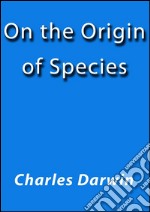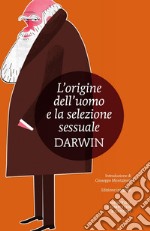The Expression of the Emotions in Man and Animals. E-book. Formato PDF - 9788832553512
di Charles Darwin
edito da IONLINESHOPPING.COM , 2019
Formato: PDF - Protezione: nessuna
The Expression of the Emotions in Man and Animals is Charles Darwin's third major work of evolutionary theory, following On the Origin of Species (1859) and The Descent of Man (1871). Initially intended as a section of The Descent of Man, it was published separately in 1872 and concerns the biological aspects of emotional life. In this book, Darwin sets out some early ideas about behavioural genetics, and explores the animal origins of such human characteristics as the lifting of the eyebrows in moments of surprise and the mental confusion which typically accompanies blushing.
Before Darwin, human emotional life had posed problems to the western philosophical categories of mind and body. Darwin's interest can be traced to his time as a medical student and the 1824 reprint of Sir Charles Bell's Anatomy and Philosophy of Expression which argued for a spiritual dimension to the subject. In contrast, Darwin's biological approach links mental states to the coordination of movement, and allows cultural factors only an auxiliary role in the shaping of expression. This biological emphasis leads to a concentration on six emotional states: happiness, sadness, fear, anger, surprise and disgust. It also leads to an appreciation of the universal nature of expression, with its implication of a single origin for the entire human species; and Darwin points to the significance of emotional communication with children in their psychological development. Darwin sought out the opinions of some leading British psychiatrists, notably James Crichton-Browne, in the preparation of the book which forms his main contribution to psychology.
Amongst the innovations with this book are Darwin's circulation of a questionnaire (probably inspired by his cousin, Francis Galton) during his preparatory research; simple psychology experiments on the recognition of emotions with his friends and family; and (borrowing from Duchenne de Boulogne, a physician at the Salpêtrière) the use of photographs in his presentation of scientific information. Publisher John Murray warned Darwin that including the photographs would "poke a hole in the profits" of the book; and The Expression of the Emotions is an important landmark in the history of book illustration.
Darwin opens the book with three chapters on "the general principles of expression", introducing the rather Lamarckist phrase serviceable associated habits. With this phrase, Darwin seeks to describe the initially voluntary actions which come together to constitute the complex expressions of emotion. He then invokes a principle of antithesis, through which opposite states of mind induce directly opposing movements. Finally, he discusses a direct action of the nervous system, in which an overflow of emotion is widely discharged, producing more generally expressed emotions.
This is followed by a section (three more chapters) on modes of emotional expression peculiar to particular species, including man. He then moves on to the main argument with his characteristic approach of astonishingly widespread and detailed observations. Chapter 7 discusses "low spirits", including anxiety, grief, dejection and despair; and the contrasting Chapter 8 "high spirits" with joy, love, tender feelings and devotion. In his discussion of "low spirits", Darwin writes: "After the mind has suffered an acute paroxysm of grief, and the cause still continues, we fall into a state of low spirits, or we may be utterly cast down and dejected. Prolonged bodily pain, if not amounting to an agony, generally leads to the same state of mind. If we expect to suffer, we are anxious; if we have no hope of relief, we despair."
Before Darwin, human emotional life had posed problems to the western philosophical categories of mind and body. Darwin's interest can be traced to his time as a medical student and the 1824 reprint of Sir Charles Bell's Anatomy and Philosophy of Expression which argued for a spiritual dimension to the subject. In contrast, Darwin's biological approach links mental states to the coordination of movement, and allows cultural factors only an auxiliary role in the shaping of expression. This biological emphasis leads to a concentration on six emotional states: happiness, sadness, fear, anger, surprise and disgust. It also leads to an appreciation of the universal nature of expression, with its implication of a single origin for the entire human species; and Darwin points to the significance of emotional communication with children in their psychological development. Darwin sought out the opinions of some leading British psychiatrists, notably James Crichton-Browne, in the preparation of the book which forms his main contribution to psychology.
Amongst the innovations with this book are Darwin's circulation of a questionnaire (probably inspired by his cousin, Francis Galton) during his preparatory research; simple psychology experiments on the recognition of emotions with his friends and family; and (borrowing from Duchenne de Boulogne, a physician at the Salpêtrière) the use of photographs in his presentation of scientific information. Publisher John Murray warned Darwin that including the photographs would "poke a hole in the profits" of the book; and The Expression of the Emotions is an important landmark in the history of book illustration.
Darwin opens the book with three chapters on "the general principles of expression", introducing the rather Lamarckist phrase serviceable associated habits. With this phrase, Darwin seeks to describe the initially voluntary actions which come together to constitute the complex expressions of emotion. He then invokes a principle of antithesis, through which opposite states of mind induce directly opposing movements. Finally, he discusses a direct action of the nervous system, in which an overflow of emotion is widely discharged, producing more generally expressed emotions.
This is followed by a section (three more chapters) on modes of emotional expression peculiar to particular species, including man. He then moves on to the main argument with his characteristic approach of astonishingly widespread and detailed observations. Chapter 7 discusses "low spirits", including anxiety, grief, dejection and despair; and the contrasting Chapter 8 "high spirits" with joy, love, tender feelings and devotion. In his discussion of "low spirits", Darwin writes: "After the mind has suffered an acute paroxysm of grief, and the cause still continues, we fall into a state of low spirits, or we may be utterly cast down and dejected. Prolonged bodily pain, if not amounting to an agony, generally leads to the same state of mind. If we expect to suffer, we are anxious; if we have no hope of relief, we despair."
Ean
9788832553512
Titolo
The Expression of the Emotions in Man and Animals. E-book. Formato PDF
Autore
Editore
Data Pubblicazione
2019
Formato
PDF
Protezione
nessuna
Punti Accumulabili







